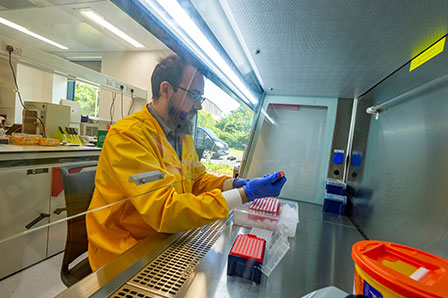Using genomic surveillance to identify waves of SARS-CoV-2 infections in Zimbabwe

Aligned with our mission to advance the understanding and impact of microbiology, the Society reached out to our community of microbiologists to share their experiences in responding to SARS-CoV-2. We aim to showcase the perspective of scientists during the COVID-19 pandemic and the variety of roles adopted to mitigate the global crisis.
This case study was written by Professor Rob Kingsley, Group Leader at the Quadram Institute. The study focusses on Rob’s genomic surveillance work in Zimbabwe through a partnership with the National Microbiology Reference Laboratory in Harare.
How did you respond to SARS-CoV-2 during the COVID-19 pandemic?
We formed one of COVID-19 Genomics UK’s sequencing centres working on SARS-CoV-2 back in March 2020 and it made sense to extend that genomic surveillance work in partnership with other countries where we had existing relationships, and that included Zimbabwe.
Part of the public health measures taken by Zimbabwe included identifying the need to understand the detailed genetic epidemiology of SARS-CoV-2 – especially its behaviour in terms of transmission, capacity to mutate and virulence.
The Ministry of Health and Child Care initially tasked its National Microbiology Reference Laboratory (NMRL) in Harare with sequencing the genetic material of positive samples from 100 COVID-19 patients, between March and June 2020. The key objectives for NMRL sought to help understand initial transmission of the disease, add context to the regional and global scientific data and to evaluate the role genomic sequencing could play in analysing the infection outbreak.
To date, more than a thousand samples have been sequenced through our partnership with NMRL, identifying subsequent waves of infection by variants of concern and placing the Zimbabwe infections in the context of the pandemic experience across the African continent. NMRL agreed to make sequences freely available via the GISAID database, benefiting the global response to the pandemic.
One of the objectives was to help NMRL build capacity for sequencing and sequence analysis within Zimbabwe itself. As a result, Zimbabwe’s NMRL has successfully sequenced genomes to help develop what could be called a ‘family tree’, or phylogenetic analysis, for the virus in Zimbabwe.
The UK’s Minister for Africa, Vicky Ford MP, acknowledged the impact of our response, noting that our joint work had a real-world impact on UK Government policy decisions. These included the removal of restrictions in relation to travel to Zimbabwe at the appropriate time and helping establish capacity to monitor the emergence of potential future threats.
In addition to helping provide real-time information on the genomic epidemiology of infection in Zimbabwe, we have also worked with colleagues in NMRL to analyse these data in detail. These have been published in peer reviewed journals Lancet Global Infection, Lancet Microbe and Science. These contribute to a large body of literature that has emerged regarding the most intensively studied epidemics in history, adding to preparedness for future pandemics.
Was this response related to your work prior to the outbreak?
Yes, we were working with Zimbabwe’s National Microbiology Reference Laboratory in Harare to investigate the association of Salmonella typhi with protists in the aquatic environment of Zimbabwe. This project is being funded by the Bill and Melinda Gates Foundation, through a new Global Grand Challenge Exploration (GCE) to examine the environmental niches of S. typhi. Key to the success of our response to the pandemic in Zimbabwe was the trust and understanding built up with NMRL scientists that enabled a rapid pivot of our work to the emergence of COVID-19.

What were some of the challenges that you faced during this time?
Logistics was the biggest challenge. Just getting consumables and samples to and from Zimbabwe was a real challenge and took considerable effort to resolve. The World Health Organisation proved invaluable in addressing some of those challenges.
How did your experience throughout the response aid in your development?
Working with colleagues in a resource-poor setting and adapting our scientific approaches to the needs of an international government responding to an ongoing emergency will help us respond to potential future crises. We now have a roadmap to respond quickly and effectively to help build critical technology and expertise capacity in resource-poor settings globally.
What can we learn about the importance of microbiology from the COVID-19 pandemic?
Microbiology has become central to the everyday functioning of our society in a way it hadn’t before. In particular, the use of genome sequencing to track the emergence and evolution of a pathogen in real time has highlighted its potential in tackling numerous infectious diseases in the future. The pandemic is likely to be a watershed moment in the application of microbiology to providing an evidence base for policymakers and solutions to other crises in waiting, including antimicrobial resistance of bacterial pathogens.
About the author

Professor Rob Kingsley is a Group Leader at the Quadram Institute. He oversees a research programme that combines bioinformatics, genomics, molecular microbiology and models of infection to investigate the evolution pathogen–host–environment interactions. Find out more about Rob's research in the Pathogen Variation Group.
